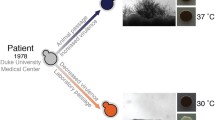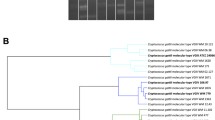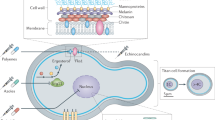Abstract
Cryptococcus neoformans serotype A strains commonly infect immunocompromised patients to cause fungal meningitis. To understand the basis of serotype A cryptococcal infections in apparently immunocompetent patients, we tested two hypotheses: the strains were naturally occurring hypervirulent pkr1 (PKA regulatory subunit) mutants, or the strains were hybrids with C. neoformans var. gattii strains that normally infect immunocompetent individuals. Analysis of clinical isolates obtained from apparently immunocompetent individuals from three continents revealed that none were pkr1 mutants, but several exhibited phenotypes consistent with perturbations in cAMP signaling. Additionally, none of the strains were unusual hybrids with gattii strains. Except for one strain that was an AD hybrid, all others were serotype A (var. grubii) isolates. Taken together, our findings indicate that the ability of these clinical isolates to infect apparently normal individuals may be attributable to mutations other than pkr1 and/or underlying immune system impairment in patients.






Similar content being viewed by others
References
Alspaugh JA, Perfect JR, Heitman J (1997) Cryptococcus neoformans mating and virulence are regulated by the G-protein a subunit GPA1 and cAMP. Genes Dev 11:3206–3217
Alspaugh JA, Pukkila-Worley R, Harashima T, Cavallo LM, Funnell D, Cox GM, Perfect JR, Kronstad JW, Heitman J (2002) Adenylyl cyclase functions downstream of the Gα protein Gpa1 and controls mating and pathogenicity of Cryptococcus neoformans. Eukaryot Cell 1:75–84
Bennett JE, Kwon-Chung KJ, Theodore TS (1978) Biochemical differences between serotypes of Cryptococcus neoformans. Sabouraudia 16:167–174
Boekhout T, Theelen B, Diaz M, Fell JW, Hop WC, Abeln EC, Dromer F, Meyer W (2001) Hybrid genotypes in the pathogenic yeast Cryptococcus neoformans. Microbiology 147:891–907
Brasier C (2000) The rise of the hybrid fungi. Nature 405:134–135
Brasier CM, Cooke DE, Duncan JM (1999) Origin of a new Phytophthora pathogen through interspecific hybridization. Proc Natl Acad Sci USA 96:5878–5883
Casadevall A, Perfect JR (1998) Cryptococcus neoformans. ASM, Washington
Chang YC, Penoyer LA, Kwon-Chung KJ (1996) The second capsule gene of Cryptococcus neoformans, CAP64, is essential for virulence. Infect Immun 64:1977–1983
Cox GM, Mukherjee J, Cole GT, Casadevall A, Perfect JR (2000) Urease as a virulence factor in experimental cryptococcosis. Infect Immun 68:443–448
D’Souza CA, Alspaugh JA, Yue C, Harashima T, Cox GM, Perfect JR, Heitman J (2001) Cyclic AMP-dependent protein kinase controls virulence of the fungal pathogen Cryptococcus neoformans. Mol Cell Biol 21:3179–3191
Dykstra MA, Friedman L, Murphy JW (1977) Capsule size of Cryptococcus neoformans: control and relationship to virulence. Infect Immun 16:129–135
Feldmesser M, Kress Y, Novikoff P, Casadevall A (2000) Cryptococcus neoformans is a facultative intracellular pathogen in murine pulmonary infection. Infect Immun 68:4225–4237
Franzot SP, Salkin IF, Casadevall A (1999) Cryptococcus neoformans var. grubii: separate varietal status for Cryptococcus neoformans serotype A isolates. J Clin Microbiol 37:838–840
Fraser JA, Subaran RL, Nichols CB, Heitman J (2003) Recapitulation of the sexual cycle of the primary fungal pathogen Cryptococcus neoformans variety gattii: implications for an outbreak on Vancouver Island. Eukaryot Cell 2:1036–1045
Granger DL, Perfect JR, Durack DT (1985) Virulence of Cryptococcus neoformans: regulation of capsule synthesis by carbon dioxide. J Clin Invest 76:508–516
Hicks JK, D’Souza CA, Cox GM, Heitman J (2004) Cyclic AMP-dependent protein kinase catalytic subunits have divergent roles in virulence factor production in two varieties of the fungal pathogen Cryptococcus neoformans. Eukaryot Cell (in press)
Hull CM, Heitman J (2002) Genetics of Cryptococcus neoformans. Annu Rev Genet 36:557–615
Kwon-Chung KJ, Bennett JE (1984) Epidemiologic differences between the two varieties of Cryptococcus neoformans. Am J Epidemiol 120:123–130
Kwon-Chung KJ, Rhodes JC (1986) Encapsulation and melanin formation as indicators of virulence in Cryptococcus neoformans. Infect Immun 51:218–223
Kwon-Chung KJ, Bennett JE, Rhodes JC (1982a) Taxonomic studies on Filobasidiella species and their anamorphs. Antonie van Leeuwenhoek 48:25–38
Kwon-Chung KJ, Polacheck I, Bennett JE (1982b) Improved diagnostic medium for separation of Cryptococcus neoformans var. neoformans (serotypes A and D) and Cryptococcus neoformans var. gattii (serotypes B and C). J Clin Microbiol 15:535–537
Kwon-Chung KJ, Polacheck I, Popkin TJ (1982c) Melanin-lacking mutants of Cryptococcus neoformans and their virulence for mice. J Bacteriol 150:1414–1421
Kwon-Chung KJ, Edman JC, Wickes BL (1992) Genetic association of mating types and virulence in Cryptococcus neoformans. Infect Immun 60:602–605
Kwon-Chung KJ, Boekhout T, Fell JW, Diaz M (2002) Proposal to conserve the name Cryptococcus gattii against C. hondurianus and C. bacilliporus (Basidiomycota, Hymenomycetes, Tremellomycetidae). Taxon 51:804–806
Lengeler KB, Cox GM, Heitman J (2001) Serotype AD strains of Cryptococcus neoformans are diploid or aneuploid and are heterozygous at the mating-type locus. Infect Immun 69:115–122
Littman ML, Tsubura E (1959) Effect of degree of encapsulation upon virulence of Cryptococcus neoformans. Proc Soc Exp Biol Med 101:773–777
Min KH, Kwon-Chung KJ (1986) The biochemical basis for the distinction between the two Cryptococcus neoformans varieties with CGB medium. Zentralbl Bakteriol Mikrobiol Hyg A 261:471–480
Newcombe G (2003) Native Venturia inopina sp. nov., specific to Populus trichocarpa and its hybrids. Mycol Res 107:108–116
Odom A, Muir S, Lim E, Toffaletti DL, Perfect J, Heitman J (1997) Calcineurin is required for virulence of Cryptococcus neoformans. EMBO J 16:2576–2589
Perfect JR, Casadevall A (2002) Cryptococcosis. Infect Dis Clin North Am 16:837–874, v–vi
Perfect JR, Ketabchi N, Cox GM, Ingram CW, Beiser CL (1993) Karyotyping of Cryptococcus neoformans as an epidemiological tool. J Clin Microbiol 31:3305–3309
Polacheck I, Kwon-Chung KJ (1986) Canavanine resistance in Cryptococcus neoformans. Antimicrob Agents Chemother 29:468–473
Salas SD, Bennett JE, Kwon-Chung KJ, Perfect JR, Williamson PR (1996) Effect of the laccase gene, CNLAC1, on virulence of Cryptococcus neoformans. J Exp Med 184:377–386
Sambrook J, Fritsch EF, Maniatis T (1989) Molecular cloning: a laboratory manual. Cold Spring Harbor Laboratory, Cold Spring Harbor, N.Y.
Sherman F (1991) Getting started with yeast. In: Guthrie C, Fink GR (eds) Methods in enzymology, vol 194. Academic, San Diego, pp 3–21
Sorrell TC (2001) Cryptococcus neoformans variety gattii. Med Mycol 39:155–168
Stephen C, Lester S, Black W, Fyfe M, Raverty S (2002) Multispecies outbreak of cryptococcosis on southern Vancouver Island, British Columbia. Can Vet J 43:792–794
Toffaletti DL, Perfect JR (1994) Biolistic DNA delivery for Cryptococcus neoformans transformation. In: Maresca B, Kobayashi GS (eds) Molecular biology of pathogenic fungal: a laboratory manual. Telos, New York, pp 303–308
Toffaletti DL, Rude TH, Johnston SA, Durack DT, Perfect JR (1993) Gene transfer in Cryptococcus neoformans by use of biolistic delivery of DNA. J Bacteriol 175:1405–1411
Vartivarian SE, Cowart RE, Anaissie EJ, Tashiro T, Sprigg HA (1995) Iron acquisition by Cryptococcus neoformans. J Med Vet Mycol 33:151–156
Wang Y, Aisen P, Cadadevall A (1995) Cryptococcus neoformans melanin and virulence: mechanism of action. Infect Immun 63:3131–3136
Wickes BL, Mayorga ME, Edman U, Edman JC (1996) Dimorphism and haploid fruiting in Cryptococcus neoformans: association with the alpha-mating type. Proc Natl Acad Sci USA 93:7327–7331
Acknowledgements
We thank Jim Kronstad and John Perfect for advice and comments on the manuscript, Cristl Arndt for technical assistance, and John Bennett, Wieland Meyer, Eric Jacobson, Barbara Alexander-Lodge, and Tom Harrison for strains. This work was supported by NIAID R01 grants AI39115 and AI42159 (to J.H.). This work was also supported by P01 award AI44975 from the NIAID to the Duke University Mycology Research Unit. J.H. is a Burroughs Wellcome Scholar in Molecular Pathogenic Mycology and an associate investigator of the Howard Hughes Medical Institute.
Author information
Authors and Affiliations
Corresponding author
Additional information
Communicated by S. Hohmann
Rights and permissions
About this article
Cite this article
D’Souza, C.A., Hagen, F., Boekhout, T. et al. Investigation of the basis of virulence in serotype A strains of Cryptococcus neoformans from apparently immunocompetent individuals. Curr Genet 46, 92–102 (2004). https://doi.org/10.1007/s00294-004-0511-y
Received:
Revised:
Accepted:
Published:
Issue Date:
DOI: https://doi.org/10.1007/s00294-004-0511-y




